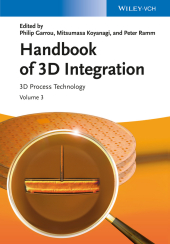 Neuerscheinungen 2014Stand: 2020-02-01 |
Schnellsuche
ISBN/Stichwort/Autor
|
Herderstraße 10
10625 Berlin
Tel.: 030 315 714 16
Fax 030 315 714 14
info@buchspektrum.de |

Philip Garrou, Mitsumasa Koyanagi, Peter Ramm
(Beteiligte)
Handbook of 3D Integration
3D Process Technology
Herausgegeben von Garrou, Philip; Koyanagi, Mitsumasa; Ramm, Peter
1. Auflage. 2014. 474 S. 48 SW-Abb., 263 Farbabb. 244 mm
Verlag/Jahr: WILEY-VCH 2014
ISBN: 3-527-33466-1 (3527334661)
Neue ISBN: 978-3-527-33466-7 (9783527334667)
Preis und Lieferzeit: Bitte klicken
3D IC INTEGRATION SINCE 2008
3D IC Nomenclature
Process Standardization
The Introduction of Interposers (2.5D)
The Foundries
Memory
The Assembly and Test Houses
3D IC Application Roadmaps
KEY APPLICATIONS AND MARKED TRENDS FOR 3D INTEGRATION AND INTERPOSER TECHNOLOGIES
Introduction
Advanced Packaging Importance in the Semiconductor Industry is Growing
3D Integration-Focused Activities - The Global IP Landscape
Applications, Technology, and Market Trends
ECONOMIC DRIVERS AND IMPEDIMENTS FOR 2.5D/3D INTEGRATION
3D Performance Advantages
The Economics of Scaling
The Cost of Future Scaling
Cost Remains the Impediment to 2.5D and 3D Product Introduction
INTERPOSER TECHNOLOGY
Definition of 2.5D Interposers
Interposer Drivers and Need
Comparison of Interposer Materials
Silicon Interposers with TSV
Lower Cost Interposers
Interposer Technical and Manufacturing Challenges
Interposer Application Examples
Conclusions
TSV FORMATION OVERVIEW
Introduction
TSV Process Approaches
TSV Fabrication Steps
Yield and Reliability
TSV UNIT PROCESSES AND INTEGRATION
Introduction
TSV Process Overview
TSV Unit Processes
Integration and Co-Optimization of Unit Processes in Via Formation Sequence
Co-Optimization of Unit Processes in Backside Processing and Via-Reveal Flow
Integration and Co-Optimization of Unit Processes in Via-Last Flow
Integration with Packaging
Electrical Characterization of TSVs
Conclusions
TSV FORMATION AT ASET
Introduction
Via-Last TSV for Both D2D and W2W Processes in ASET
TSV Process for D2D
TSV Process for W2W
Conclusions
LASER-ASSISTED WAFER PROCESSING: NEW PERSPECTIVES IN THROUGH-SUBSTRATE VIA DRILLING AND REDISTRIBUTION LAYER DEPOSITION
Introduction
Laser Drilling of TSVs
Direct-Write Deposition of Redistribution Layers
Conclusions and Outlook
TEMPORARY BONDING MATERIAL REQUIREMENTS
Introduction
Technology Options
Requirements of a Temporary Bonding Material
Considerations for Successful Processing
Surviving the Backside Process
Debonding
TEMPORARY BONDING AND DEBONDING - AN UPDATE ON MATERIALS AND METHODS
Introduction
Carrier Selection for Temporary Bonding
Selection of Temporary Bonding Adhesives
Bonding and Debonding Processes
Equipment and Process Integration
ZONEBOND©: RECENT DEVELOPMENTS IN TEMPORARY BONDING AND ROOM-TEMPERATURE DEBONDING
Introduction
Thin Wafer Processing
ZoneBOND Room-Temperature Debonding
Conclusions
TEMPORARY BONDING AND DEBONDING AT TOK
Introduction
Zero Newton Technology
Conclusions
THE 3M (TM) WAFER SUPPORT SYSTEM (WSS)
Introduction
System Description
General Advantages
High-Temperature Material Solutions
Process Considerations
Future Directions
Summary
COMPARISON OF TEMPORARY BONDING AND DEBONDING PROCESS FLOWS
Introduction
Studies of Wafer Bonding and Thinning
Backside Processing
Debonding and Cleaning
THINNING, VIA REVEAL, AND BACKSIDE PROCESSING - OVERVIEW
Introduction
Wafer Edge Trimming
Thin Wafer Support Systems
Wafer Thinning
Thin Wafer Backside Processing
BACKSIDE THINNING AND STRESS-RELIEF TECHNIQUES FOR THIN SILICON WAFERS
Introduction
Thin Semiconductor Devices
Wafer Thinning Techniques
Fracture Tests for Thin Silicon Wafers
Comparison of Stress-Relief Techniques for Wafer Backside Thinning
Process Flow for Wafer Thinning and Dicing
Summary and Outlook on 3D Integration
VIA REVEAL AND BACKSIDE PROCESSING
Introduction
Via Reveal and Backside Processing in Via-Middle Process
Backside Processing in Back-Via Process
Backside Processing and Impurity Gettering
Backside Processing for RDL Formation
DICING, GRINDING, AND POLISHING (KIRU KEZURU AND MIGAKU)
Introduction
Grinding and Polishing
Dicing
Summary
OVERVIEW OF BONDING AND ASSEMBLY FOR 3D INTEGRATION
Introduction
Direct, Indirect, and Hybrid Bonding
Requirements for Bonding Process and Materials
Bonding Quality Characterization
Discussion of Specific Bonding and Assembly Technologies
Summary and Conclusions
BONDING AND
Edited by key figures in the field and written by top authors from academia and industry, this book covers the intricate details of 3D process technology from both a technological and a materials science perspective.


